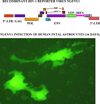HIV-1 endocytosis in astrocytes: a kiss of death or survival of the fittest?
- PMID: 25219546
- PMCID: PMC4452007
- DOI: 10.1016/j.neures.2014.08.013
HIV-1 endocytosis in astrocytes: a kiss of death or survival of the fittest?
Abstract
The brain is a target of HIV-1 and serves as an important viral reservoir. Astrocytes, the most abundant glial cell in the human brain, are involved in brain plasticity and neuroprotection. Several studies have reported HIV-1 infection of astrocytes in cell cultures and infected brain tissues. The prevailing concept is that HIV-1 infection of astrocytes leads to latent infection. Here, we provide our perspective on endocytosis-mediated HIV-1 entry and its fate in astrocytes. Natural entry of HIV-1 into astrocytes occurs via endocytosis. However, endocytosis of HIV-1 in astrocytes is a natural death trap where the majority of virus particles are degraded in endosomes and a few which escape intact lead to successful infection. Thus, regardless of artificial fine-tuning (treatment with cytokines or proinflammatory products) done to astrocytes, HIV-1 does not infect them efficiently unless the viral entry route or the endosomal enzymatic machinery has been manipulated.
Keywords: Chloroquine; DDX3; HIV-1 brain; HIV-1 latency; HIV-1 reservoir; Rab.
Copyright © 2014 Elsevier Ireland Ltd and the Japan Neuroscience Society. All rights reserved.
Figures



Similar articles
-
Endocytosis of human immunodeficiency virus 1 (HIV-1) in astrocytes: a fiery path to its destination.Microb Pathog. 2015 Jan;78:1-6. doi: 10.1016/j.micpath.2014.11.003. Epub 2014 Nov 4. Microb Pathog. 2015. PMID: 25448132 Free PMC article. Review.
-
Endocytosis-mediated HIV-1 entry and its significance in the elusive behavior of the virus in astrocytes.Virology. 2014 May;456-457:1-19. doi: 10.1016/j.virol.2014.03.002. Epub 2014 Mar 25. Virology. 2014. PMID: 24889220 Free PMC article.
-
Enigma of HIV-1 latent infection in astrocytes: an in-vitro study using protein kinase C agonist as a latency reversing agent.Microbes Infect. 2015 Sep;17(9):651-9. doi: 10.1016/j.micinf.2015.05.006. Epub 2015 Jun 2. Microbes Infect. 2015. PMID: 26043820 Free PMC article.
-
Productive HIV infection in astrocytes can be established via a nonclassical mechanism.AIDS. 2020 Jun 1;34(7):963-978. doi: 10.1097/QAD.0000000000002512. AIDS. 2020. PMID: 32379159 Free PMC article.
-
Stages of restricted HIV-1 infection in astrocyte cultures derived from human fetal brain tissue.J Neurovirol. 2000 May;6 Suppl 1:S90-4. J Neurovirol. 2000. PMID: 10871771 Review.
Cited by
-
Absence of LEDGF/p75 Expression in Astrocytes May Affect HIV-1 Integration Efficiency.Mol Gen Microbiol Virol. 2019;34(2):81-83. doi: 10.3103/s0891416819020113. Epub 2019 Oct 14. Mol Gen Microbiol Virol. 2019. PMID: 33867663 Free PMC article.
-
Astrocytes Are a Key Target for Neurotropic Viral Infection.Cells. 2023 Sep 19;12(18):2307. doi: 10.3390/cells12182307. Cells. 2023. PMID: 37759529 Free PMC article. Review.
-
Neuropathogenesis of HIV: from initial neuroinvasion to HIV-associated neurocognitive disorder (HAND).Curr HIV/AIDS Rep. 2015 Mar;12(1):16-24. doi: 10.1007/s11904-014-0255-3. Curr HIV/AIDS Rep. 2015. PMID: 25604237 Free PMC article. Review.
-
Pancreatogenic Diabetes: Triggering Effects of Alcohol and HIV.Biology (Basel). 2021 Feb 3;10(2):108. doi: 10.3390/biology10020108. Biology (Basel). 2021. PMID: 33546230 Free PMC article. Review.
-
Astrocytes are HIV reservoirs in the brain: A cell type with poor HIV infectivity and replication but efficient cell-to-cell viral transfer.J Neurochem. 2021 Jul;158(2):429-443. doi: 10.1111/jnc.15336. Epub 2021 Mar 22. J Neurochem. 2021. PMID: 33655498 Free PMC article.
References
-
- An SF, Groves M, Giometto B, Beckett AA, Scaravilli F. Detection and localisation of HIV-1 DNA and RNA in fixed adult AIDS brain by polymerase chain reaction/in situ hybridisation technique. Acta Neuropathol. 1999a;98(5):481–487. - PubMed
-
- An SF, Groves M, Gray F, Scaravilli F. Early entry and widespread cellular involvement of HIV-1 DNA in brains of HIV-1 positive asymptomatic individuals. J Neuropathol Exp Neurol. 1999b;58(11):1156–1162. - PubMed
-
- Atwood WJ, Tornatore CS, Traub R, Conant K, Drew PD, Major EO. Stimulation of HIV type 1 gene expression and induction of NF-kappa B (p50/p65)-binding activity in tumor necrosis factor alpha-treated human fetal glial cells. AIDS Res Hum Retroviruses. 1994;10(10):1207–1211. - PubMed
-
- Bagasra O, Lavi E, Bobroski L, Khalili K, Pestaner JP, Tawadros R, Pomerantz RJ. Cellular reservoirs of HIV-1 in the central nervous system of infected individuals: identification by the combination of in situ polymerase chain reaction and immunohistochemistry. AIDS. 1996;10(6):573–585. - PubMed
Publication types
MeSH terms
Grants and funding
LinkOut - more resources
Full Text Sources
Other Literature Sources
Medical

